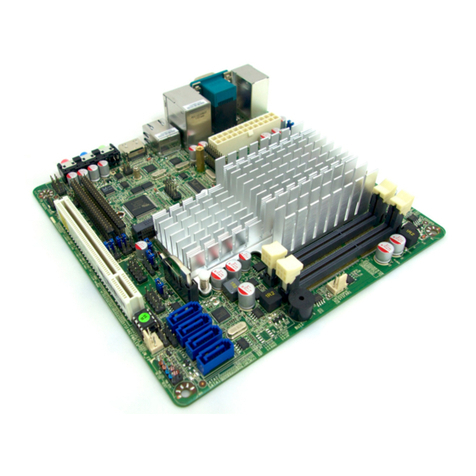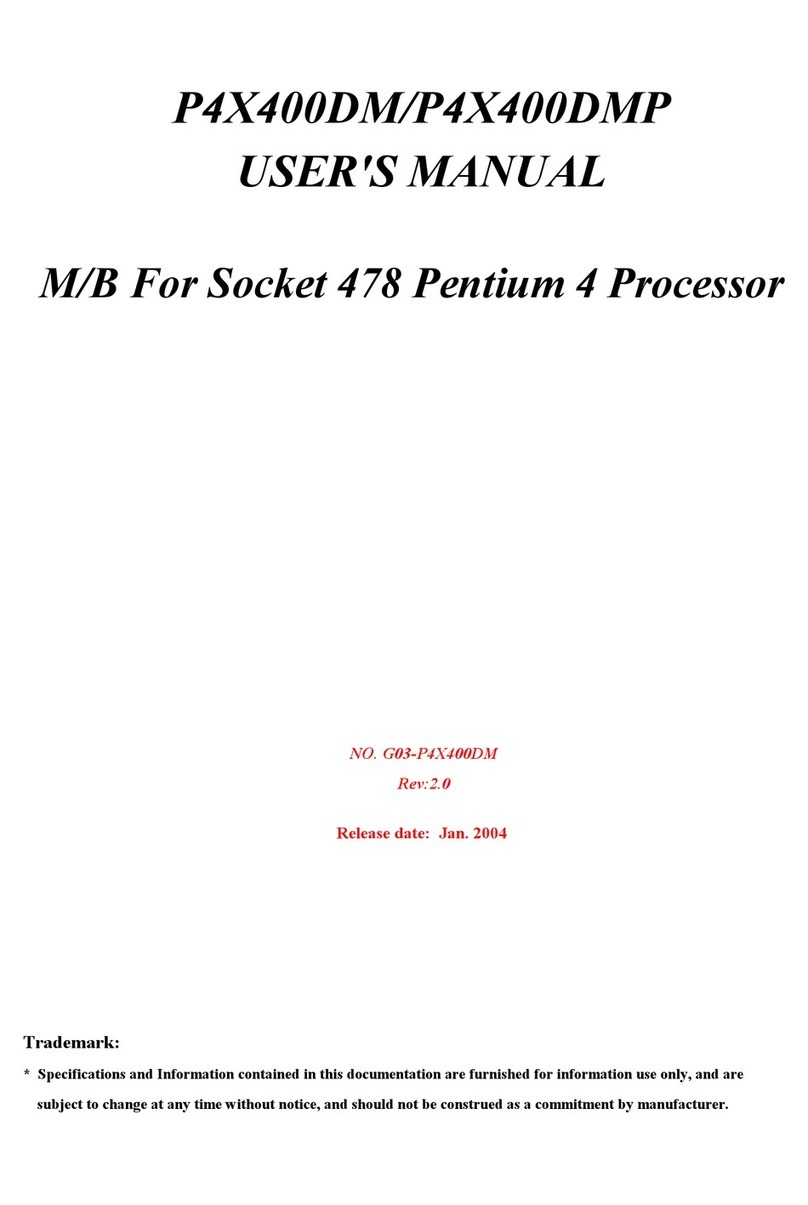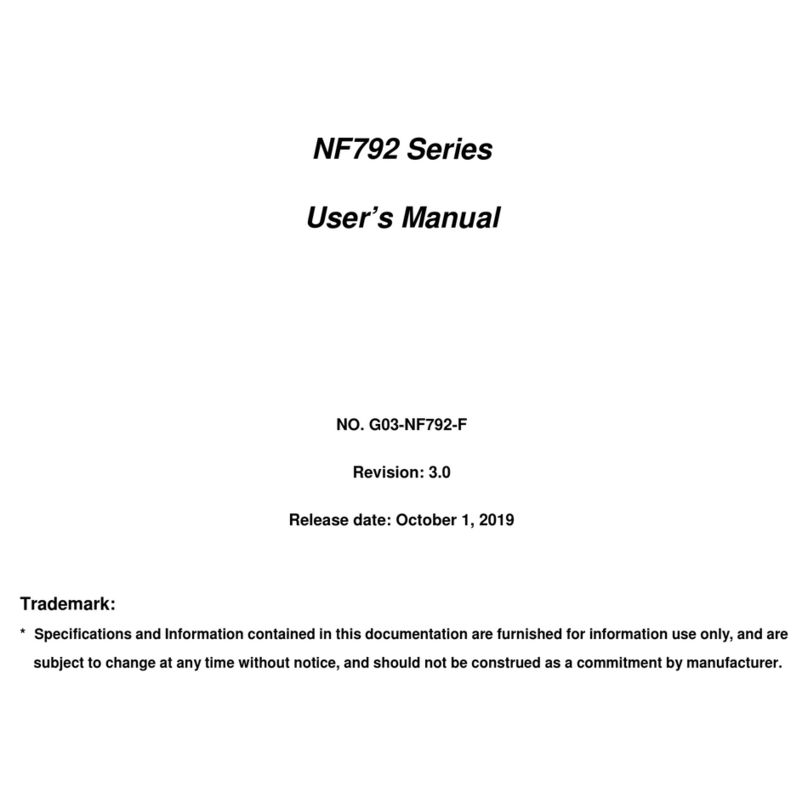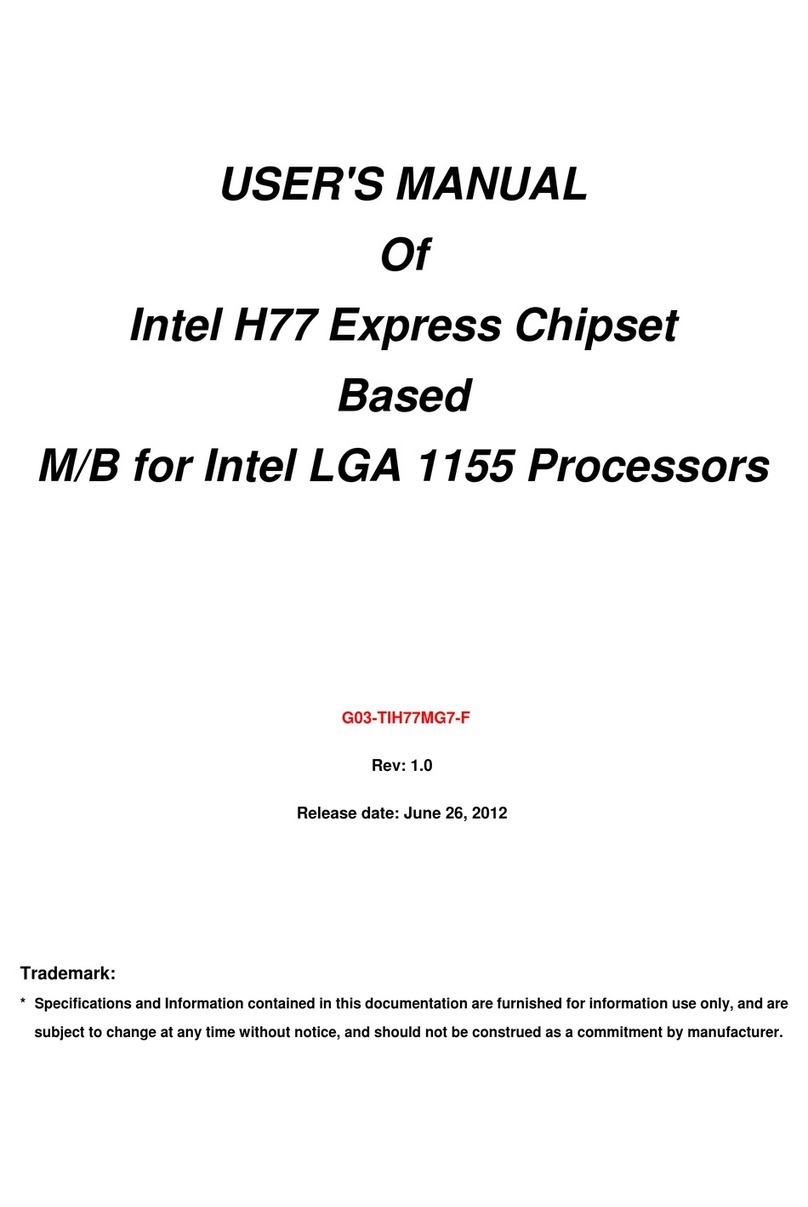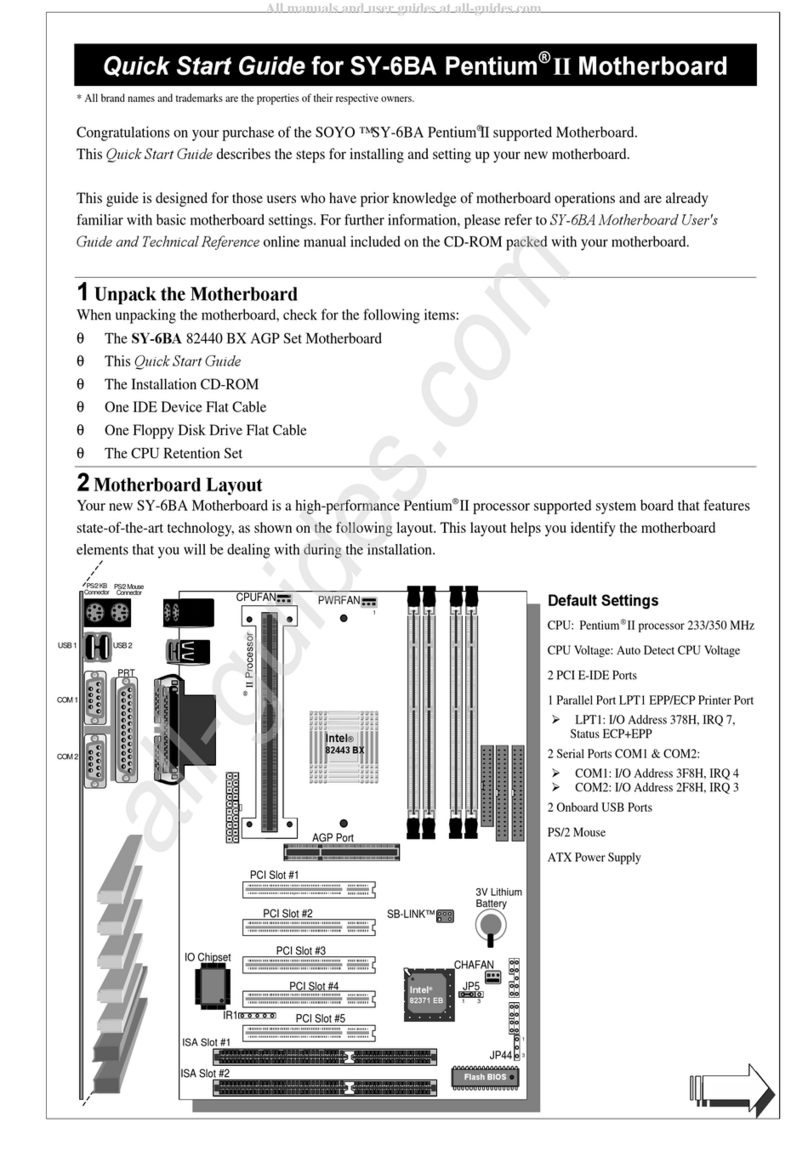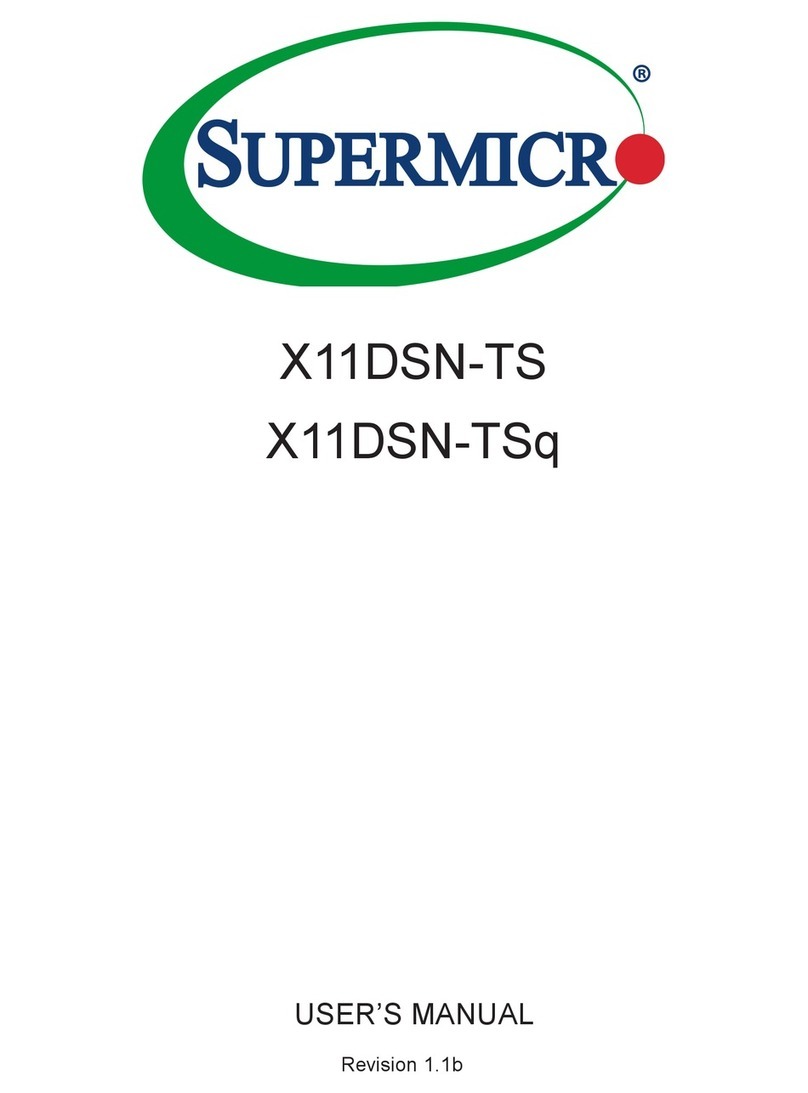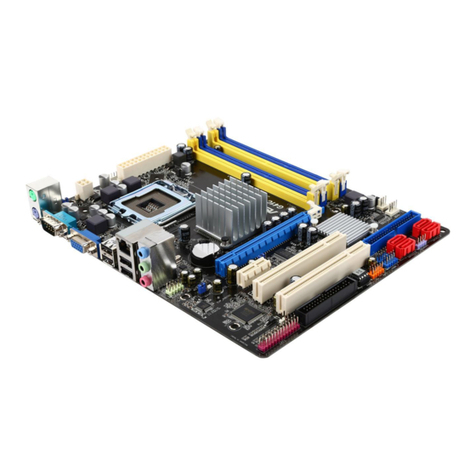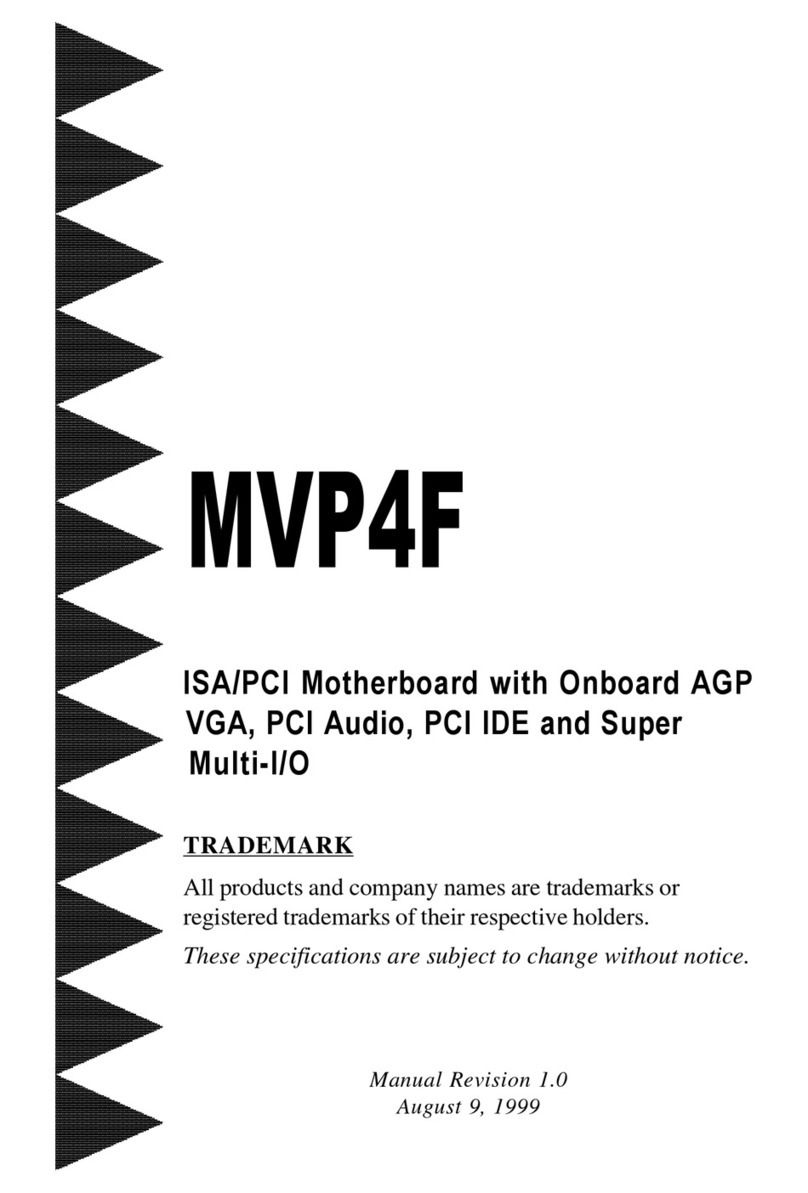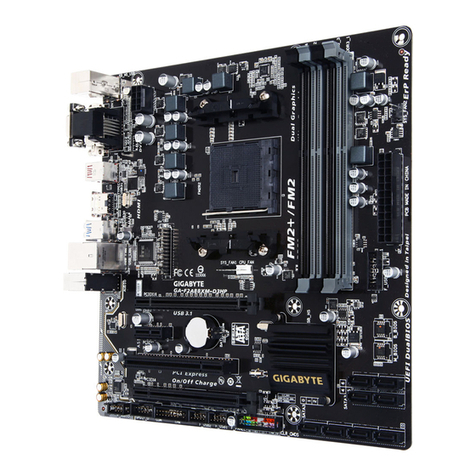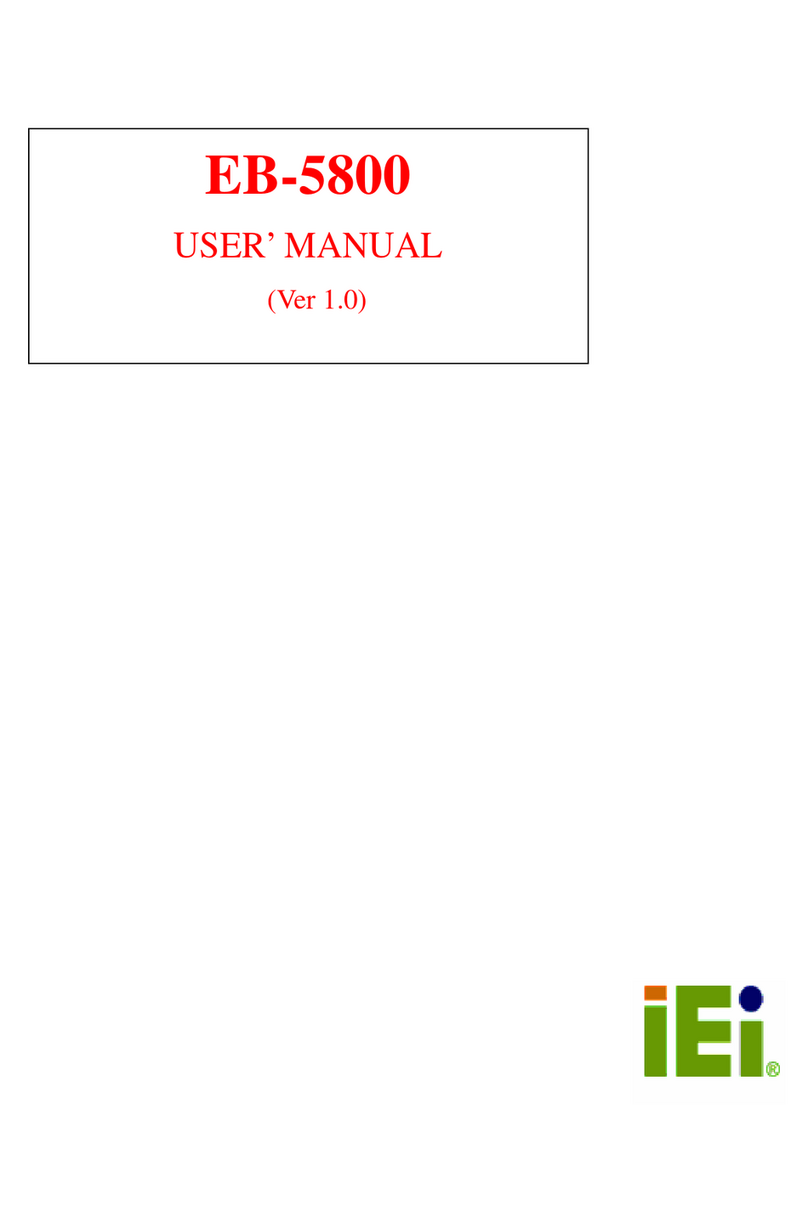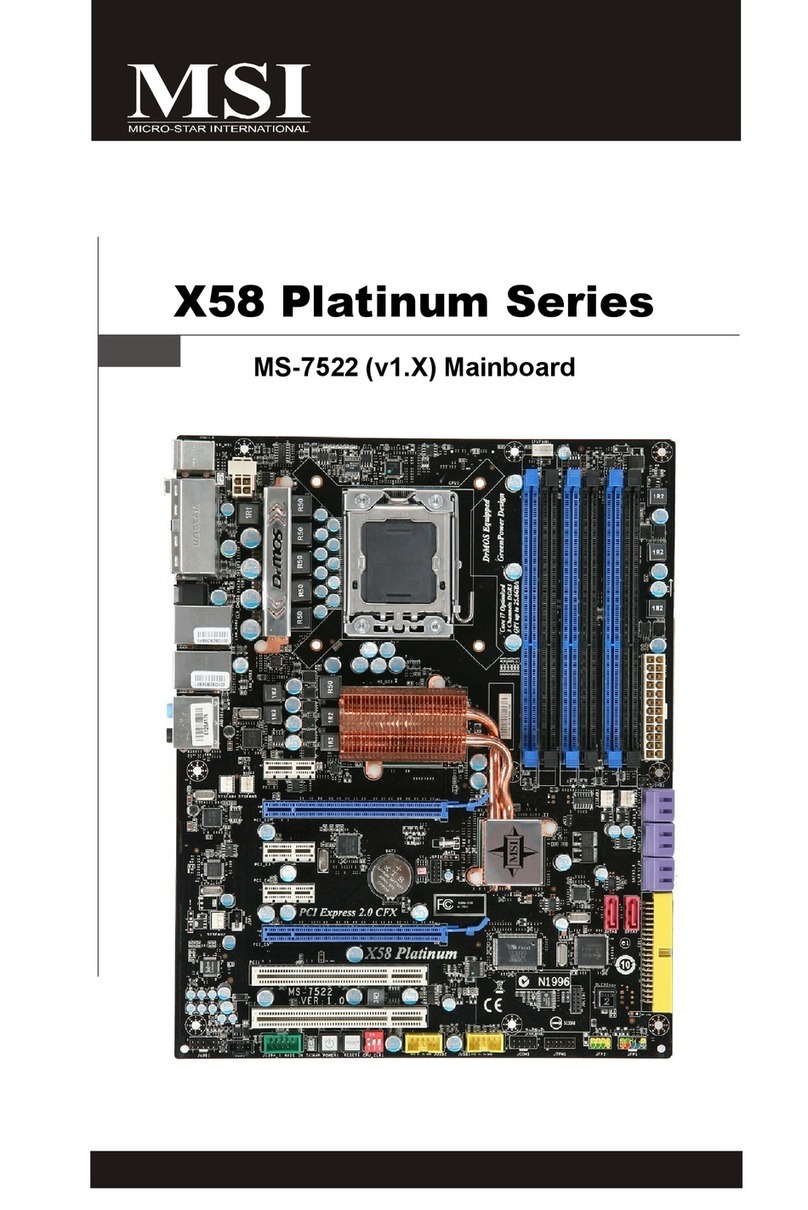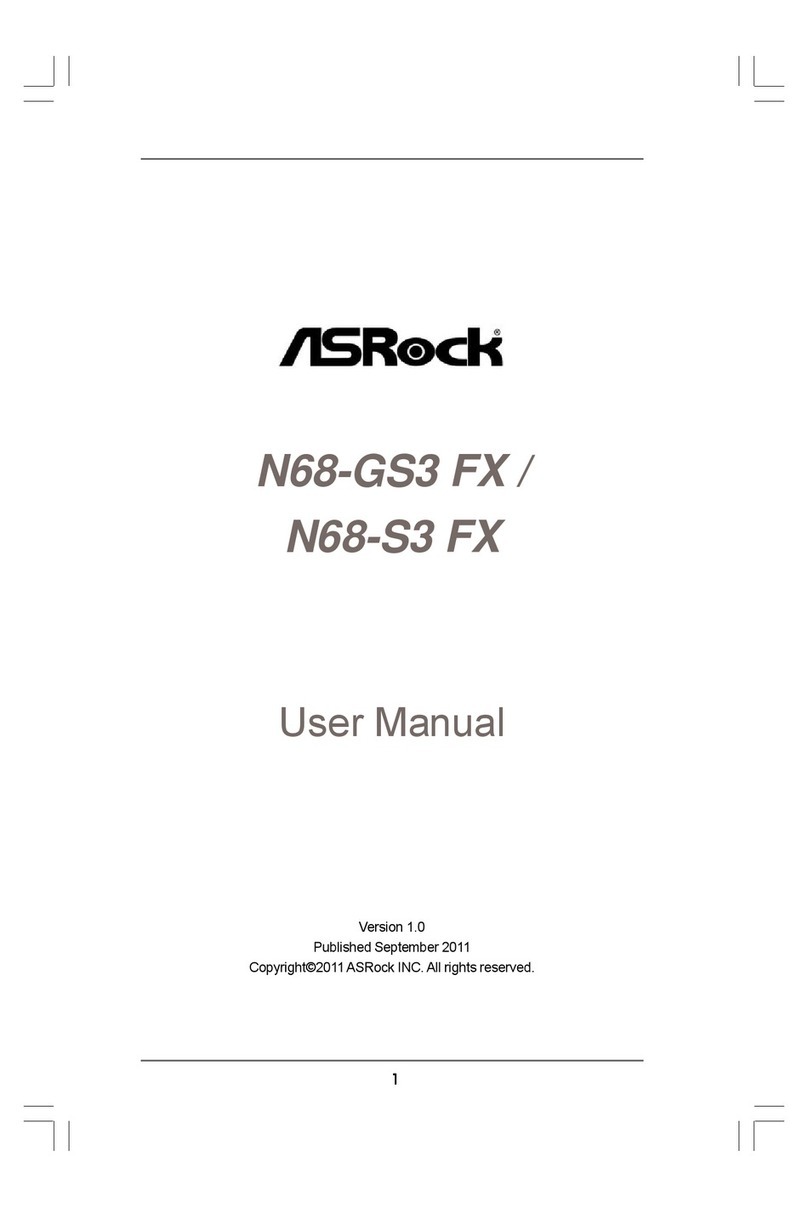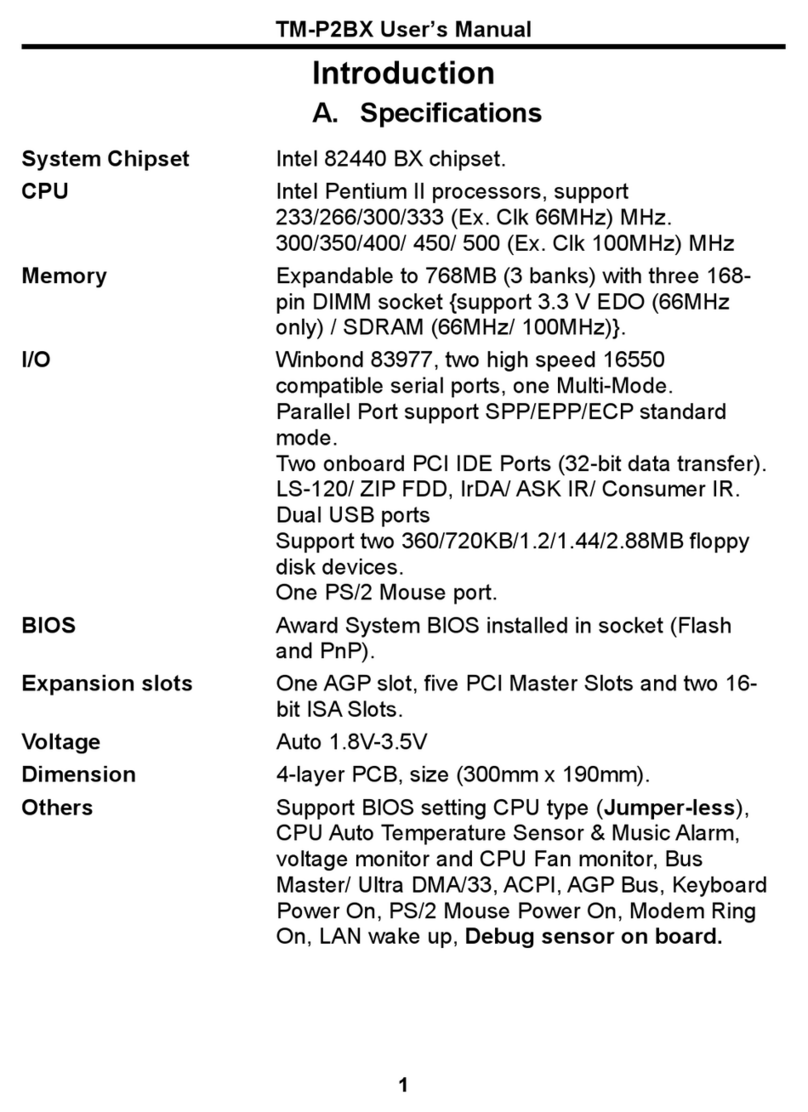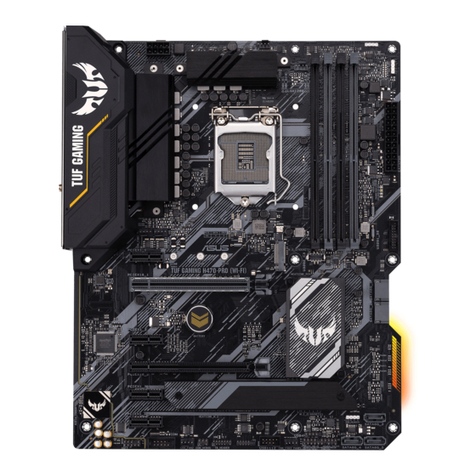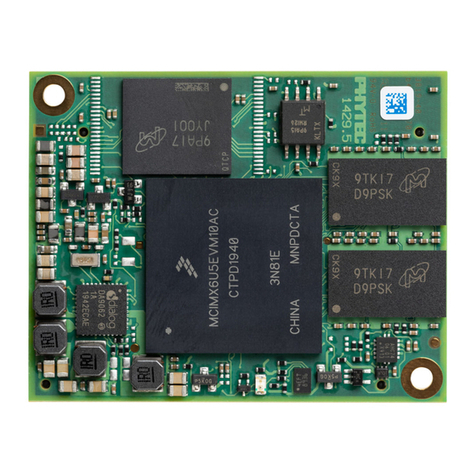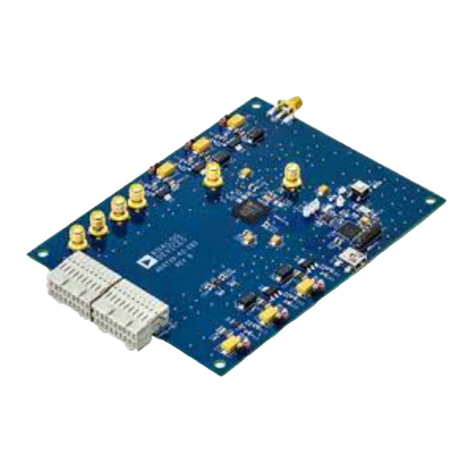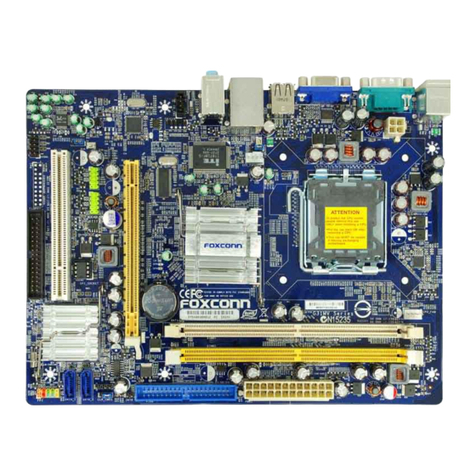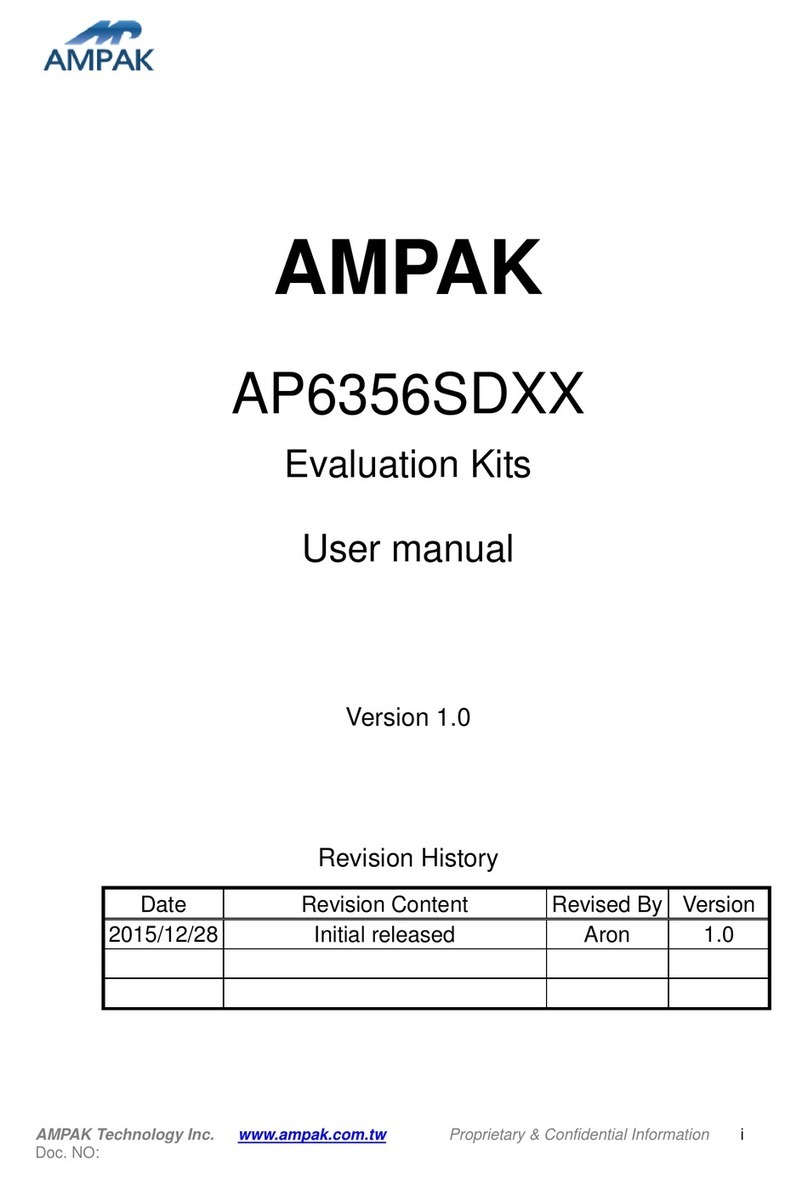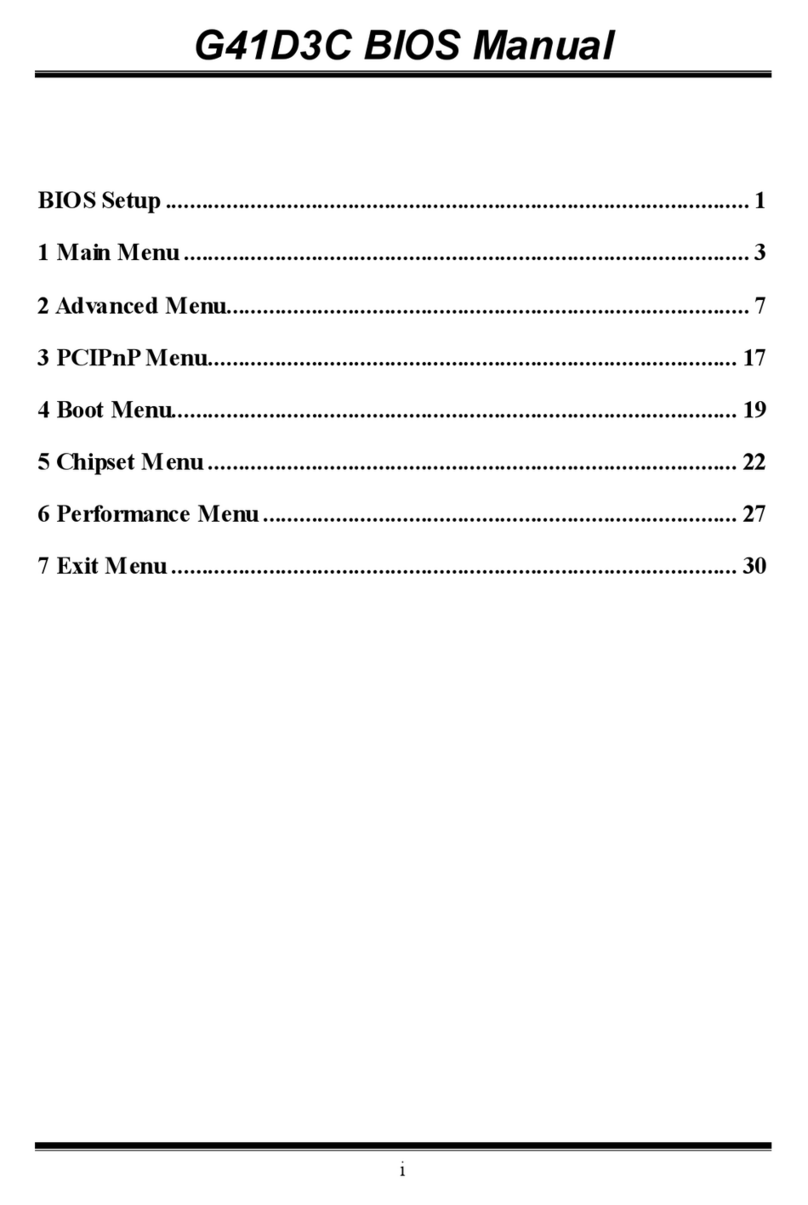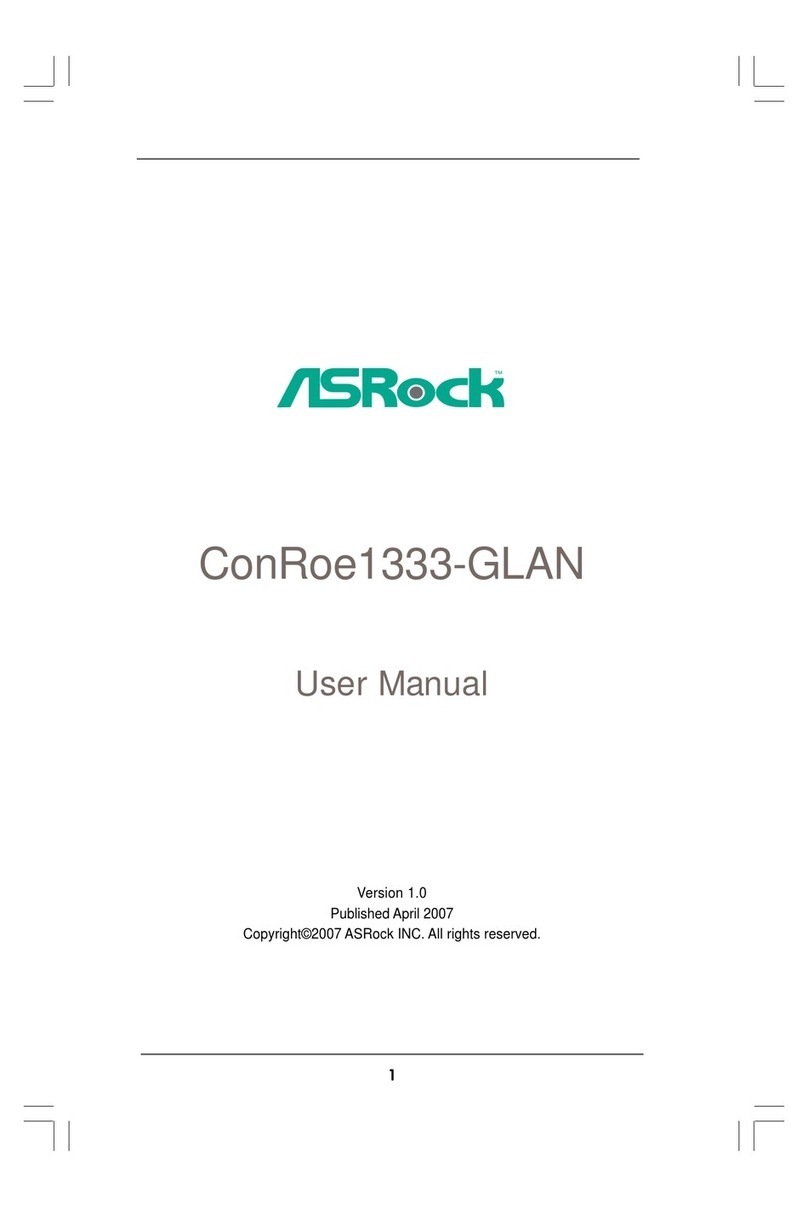JETWAY NF9M User manual

Technical Manual
Of
Intel Bay Trail Series CPU
Based Mini-ITX M/B
NO.G03-NF9M-F
Revision: 1.0
Release date: March 12, 2014
Trademark:
* Specifications and Information contained in this documentation are furnished for information use only, and are
subject to change at any time without notice, and should not be construed as a commitment by manufacturer.

ii
Environmental Protection Announcement
Do not dispose this electronic device into the trash while discarding. To minimize
pollution and ensure environment protection of mother earth, please recycle.

iii
ENVIRONMENTAL SAFETY INSTRUCTION...........................................................................iv
USER’S NOTICE .......................................................................................................................v
MANUAL REVISION INFORMATION .......................................................................................v
ITEM CHECKLIST .....................................................................................................................v
CHAPTER 1 INTRODUCTION OF THE MOTHERBOARD
1-1 FEATURE OF MOTHERBOARD ................................................................................1
1-2 SPECIFICATION .........................................................................................................2
1-3 LAYOUT DIAGRAM ....................................................................................................3
CHAPTER 2 HARDWARE INSTALLATION
2-1 JUMPER SETTING .....................................................................................................8
2-2 CONNECTORS AND HEADERS................................................................................14
2-2-1 CONNECTORS .............................................................................................14
2-2-2 HEADERS .....................................................................................................16
CHAPTER 3 INTRODUCING BIOS
3-1 ENTERING SETUP .....................................................................................................25
3-2 BIOS MENU SCREEN ................................................................................................26
3-3 FUNCTION KEYS .......................................................................................................26
3-4 GETTING HELP ..........................................................................................................27
3-5 MEMU BARS...............................................................................................................27
3-6 MAIN MENU ................................................................................................................28
3-7 ADVANCED MENU.....................................................................................................29
3-8 CHIPSET MENU..........................................................................................................39
3-9 SECURITY MENU .......................................................................................................42
3-10 BOOT MENU...............................................................................................................43
3-11 SAVE & EXIT MENU...................................................................................................44
TABLE OF CONTENT

iv
Environmental Safety Instruction
Avoid the dusty, humidity and temperature extremes. Do not place the product in
any area where it may become wet.
0 to 60 centigrade is the suitable temperature. (The figure comes from the request
of the main chipset)
Generally speaking, dramatic changes in temperature may lead to contact
malfunction and crackles due to constant thermal expansion and contraction from
the welding spots’ that connect components and PCB. Computer should go
through an adaptive phase before it boots when it is moved from a cold
environment to a warmer one to avoid condensation phenomenon. These water
drops attached on PCB or the surface of the components can bring about
phenomena as minor as computer instability resulted from corrosion and oxidation
from components and PCB or as major as short circuit that can burn the
components. Suggest starting the computer until the temperature goes up.
The increasing temperature of the capacitor may decrease the life of computer.
Using the close case may decrease the life of other device because the higher
temperature in the inner of the case.
Attention to the heat sink when you over-clocking. The higher temperature may
decrease the life of the device and burned the capacitor.

v
USER’S NOTICE
COPYRIGHT OF THIS MANUAL BELONGS TO THE MANUFACTURER. NO PART OF THIS MANUAL,
INCLUDING THE PRODUCTS AND SOFTWARE DESCRIBED IN IT MAY BE REPRODUCED, TRANSMITTED
OR TRANSLATED INTO ANY LANGUAGE IN ANY FORM OR BY ANY MEANS WITHOUT WRITTEN
PERMISSION OF THE MANUFACTURER.
THIS MANUAL CONTAINS ALL INFORMATION REQUIRED TO USE THIS MOTHER-BOARD SERIES AND WE
DO ASSURE THIS MANUAL MEETS USER’S REQUIREMENT BUT WILL CHANGE, CORRECT ANY TIME
WITHOUT NOTICE. MANUFACTURER PROVIDES THIS MANUAL “AS IS” WITHOUT WARRANTY OF ANY
KIND, AND WILL NOT BE LIABLE FOR ANY INDIRECT, SPECIAL, INCIDENTIAL OR CONSEQUENTIAL
DAMAGES (INCLUDING DAMANGES FOR LOSS OF PROFIT, LOSS OF BUSINESS, LOSS OF USE OF DATA,
INTERRUPTION OF BUSINESS AND THE LIKE).
PRODUCTS AND CORPORATE NAMES APPEARING IN THIS MANUAL MAY OR MAY NOT BE
REGISTERED TRADEMARKS OR COPYRIGHTS OF THEIR RESPECTIVE COMPANIES, AND THEY ARE
USED ONLY FOR IDENTIFICATION OR EXPLANATION AND TO THE OWNER’S BENEFIT, WITHOUT
INTENT TO INFRINGE.
Manual Revision Information
Reversion Revision History Date
1.0 First Edition March 12, 2014
Item Checklist
Motherboard
User’s Manual
CD for motherboard utilities
Cable(s)

1
Chapter 1
Introduction of the Motherboard
1-1 Feature of Motherboard
Onboard Intel® Bay Trail Series Processor, with low power consumption never
denies high performance
Support 2 * DDRIIIL SO-DIMM 1066/1333 MHz up to 8GB
Support Mini-PCIE connector
Support m-SATA connector
Support 2 * SATAII device
Integrated with 1 * 24-bit dual channel LVDS header
Support DVI-I output
Support USB 3.0 data transport demand
Support CPU Smart FAN
Compliance with ErP standard
Support Watchdog function

2
1-2 Specification
Spec Description
Design 6 layers; PCB size: 17x 17 cm
Embedded CPU NF9M-2930 Series: Intel® Bay Trail-M N2930 SoC CPU
NF9M-3827 Series: Intel® Bay Trail-I E3827 SoC CPU
Memory Slot 2 * DDRIIIL SODIMM Slot for un-buffered dual channel DDRIIIL
1333 MHz SDRAM, expandable to 8GB
Expansion Slot 1* Half-size Mini-PCIE slot
1* PCIE x1 slot
LAN Chip
Integrated with dual Realtek RTL8111G PCI-E Gigabit LAN chips
Support Fast Ethernet LAN function of providing
10/100/1000Mbps Ethernet data transfer rate
Storage 2* SATAII port
1* mSATA slot
BIOS AMI 64MB Flash ROM
Rear I/O
1* DC 9V~36V power-in connector
1* USB 3.0 port
3* USB 2.0 port
1* DVI-I port
1* COM port
1* RJ-45 LAN port
Audio Line Out port x1
Internal I/O
2* SATAII 3Gb/s port
1* SATA Power connector
1* CPU FAN header
2* SYSFAN header
1* Front panel audio header
1* SPDIF Out header

3
1* SPEAK_CON header
1* Parallel port header
3* Serial port header
1* USB 2.0 header (Expansible to 2* USB 2.0 ports)
1* USB 3.0 header (Expansible to 2* USB 3.0 ports)
1* Power LED & speaker header
1* Front panel header
1* GPIO_CON header
1* PS2KBMS header
1* SMBUS header
1* LAN LED activity header
1* LVDS header
1* LVDS inverter
1-3 Layout Diagram
Rear IO Panel Diagram:
Line-
Out Port
USB 2.0 Ports
RJ-45 LAN Port
USB 3.0 Port
9V~36V
DC Power-in
Connector
USB 2.0 Port
DVI-
I Port
COM1 Port

4
Motherboard Internal Diagram
9V~36V Internal
Power connector
Intel CPU
PCI Express x1 Slot
CPUFAN Header
Front Panel
Audio Header
Front Panel Header
LVDS Inverter
Serial Port Headers
(COM2/3/4)
GPIO Header
SATA Hard Disk
Power-Out Connector
Speaker
Connector
USB 3.0 Header
LVDS Header
SATAII Ports
SYSFAN2 Header
SYSFAN1 Header
LAN_LED Header
DDR3L SODIMM Slot
(SODIMM1)
DDR3L SODIMM Slot
(SODIMM2)
Parallel Port Header
PS2KBMS Header
SMBUS Header
Power LED Header
& Speaker Header
Half-size
Mini-PCIE Slot (MPE)
9V ~36V DC
Power-in Connector
M-SATA Slot
USB 3.0 Port
Over USB 2.0 Port
DVI-I Port
COM1 Port
USB 2.0 Ports
RJ-45 LAN Port
Line-Out Port
USB 2.0 Header

5
Jumper Position:
JP1
JP3
JP4
JBAT
COPEN
AT-MODE
ME_RTC
SYSFAN-DET
JP5
JP6
JP7
JP2

6
Jumper
Jumper Name Description
JBAT CMOS RAM Clear Function Setting 2-Pin Block
ME_RTC Clear ME RTC Function Setting 2-Pin Block
COPEN Case Open Message Display Function
2-Pin Block
AT_MODE AT Mode Function Select 2-Pin Block
SYSFAN_DET
SYSFAN1/SYSFAN2 R.P.M. Select 3-Pin Block
JP1 Security Measure Function Select 2-Pin Block
JP3 LVDS PVCC 5V/3.3V /12V Select 4-Pin Block
JP4 LCD Back Light 5V/12V/DCIN Select 4-Pin Block
JP2 COM1 Port Pin9 Function Select 4-Pin Block
JP5 COM2 Header Pin9 Function Select 4-Pin Block
JP6 COM3 Header Pin9 Function Select 4-Pin Block
JP7 COM4 Header Pin9 Function Select 4-Pin Block
Connectors
Connector Name
DCIN DC 9V~36V Power–in Connector
SATA1/SATA2 SATAII Port Connector
SATAPW SATA Power out Connector
CPUFAN CPUFAN Connector
SYSFAN1/SYSFAN2 SYSFAN Connector X2
USB20/USB30(Top) USB 2.0 Port Connector X3
USB30(Bottom) USB 3.0 Port Connector
LAN RJ-45 LAN Port Connector
DVI-I DVI-I Port Connector
COM1 Serial port
LINE_OUT Audio Line Out Connector

7
Headers
Header Name Description
FP_AUDIO Front Panel Audio Header 9-pin Block
SPDIF SPDIF Out Header 2-pin Block
SPEAK_CON Speaker Header 4-pin Block
LPT Parallel Port Header 25-pin Block
COM2/3/4 Serial Port Header X3 9-pin Block
GPIO_CON GPIO Header 10-pin Block
FP_USB20 USB 2.0 Header 9-pin Block
FP_USB30 USB 3.0 Header 19-pin Block
SPK-LED Power LED & Speaker Header 7-pin Block
JW_FP
Front Panel Header(PWR LED/
HDD LED/Power Button /Reset)
9-pin Block
PS2KBMS PS/2 Keyboard & Mouse Header 6-pin Block
SMBUS SMBUS Header 4-pin Block
LAN_LED LAN Activity LED Header 2-pin Block
LVDS LVDS Header 30-pin Block
INVERTER LVDS Inverter 8-pin Block

8
Chapter 2
Hardware Installation
2-1 Jumper Setting
(1) JBAT (2-pin): Clear CMOS Setting
CMOS Clear Setting
1-2 Closed:Clear CMOS
JBAT
1-2 Open: Normal;
1
(2)ME_RTC (2-pin): Clear ME_RTC Function Setting
CMOS ME_RTC Setting
1-2 Closed:Clear ME_RTC.
ME_RTC
1-2 Open: Normal;
1

9
(3)COPEN (2-pin): Case Open Message Display Function Select
1-2 Closed: Case Open
Function Selected (One Touch).
COPEN
1
2
1-2 Open: Normal;
1
2
Pin 1-2 Closed: When Case open function pin short to GND, the Case open function
was detected. When Used, needs to enter BIOS and enable ‘Case Open Detect’
function. In this case if your case is removed, next time when you restart your computer,
a message will be displayed on screen to inform you of this.
(4)AT_MODE (2-pin): AT Mode Function Select
1-2 Closed: AT Mode Selected.
AT_MODE
1
2
1-2 Open: ATX Mode Selected;
1
2

10
Pin 1-2 closed: AT_MODE function is enabled. User needs to restart the system for
the settings to take effect. In this case your computer will automatically turns on when
power supply resumes.
(5) SYSFAN_DET (3-pin): SYSFAN1/SYSFAN2 R.P.M. Select
SYSFAN_DET
1-2 Closed:
SYSFAN1 R.P.M. Selected;
1
3
1
3
2-3 Closed:
SYSFAN2 R.P.M. Selected.
(6)JP1 (2-pin): Security Measure Function Select
1-2 Closed: Disable Security Measures
in the Flash Descriptor(Override).
JP1
1
1-2 Open:Enable Security Measures
in the Flash Descriptor(Default);
1

11
(7) JP3 (4-pin): LVDS PVCC 3.3V/5V/12V Function Select
JP3→LVDS PVCC
4-6 Closed:
VCC= 12V.
1
3
5
3-4 Closed:
VCC= 5V;
2-4 Closed:
VCC=3.3V;
4
6
2
6
5
3
1
4
2
5
3
1
6
4
2
(8) JP4 (4-pin): LCD Back Light VCC 3.3V/5V/12V Select
JP4→LCD Back Light
4-6 Closed:
VCC= DCIN.
1
3
5
3-4 Closed:
VCC= 12V;
2-4 Closed:
VCC=5V;
4
6
2
6
5
3
1
4
2
5
3
1
6
4
2

12
(9) JP2 (4-pin): COM1 Port Pin9 Function Select
JP2→COM1
4-6 Closed:
RI= 12V.
6
4
2
3-4 Closed:
RI= 5V;
2-4 Closed:
RI=RS232;
3
1
5
1
3
5
2
4
6
1
3
5
2
4
6
(10) JP5 (4-pin): COM2 Header Pin9 Function Select
JP5→COM2 Header
4-6 Closed:
RI= 12V.
1
3
5
3-4 Closed:
RI= 5V;
2-4 Closed:
RI=RS232;
4
6
2
6
5
3
1
4
2
5
3
1
6
4
2

13
(11) JP6 (4-pin): COM3 Header Pin9 Function Select
JP6→COM3 Header
4-6 Closed:
RI= 12V.
1
3
5
3-4 Closed:
RI= 5V;
2-4 Closed:
RI=RS232;
4
6
2
6
5
3
1
4
2
5
3
1
6
4
2
(12) JP7 (4-pin): COM4 Header Pin9 Function Select
JP7→COM4 Header
4-6 Closed:
RI= 12V.
1
3
5
3-4 Closed:
RI= 5V;
2-4 Closed:
RI=RS232;
4
6
2
6
5
3
1
4
2
5
3
1
6
4
2

14
2-2 Connectors and Headers
2-2-1 Connectors
(1) Rear I/O Connectors
(2) SATAII Port connector: SATA1/SATA2
These are high-speed SATAII ports that support 3GB/s transfer rate.
Pin No. Definition
1 GND
2 TXP
3 TXN
4 GND
5 RXN
6 RXP
7 GND
Line-
Out Port
USB 2.0 Ports
RJ-45 LAN Port
USB 3.0 Port
9V~36V
DC Power-in
Connector
USB 2.0 Port
DVI-
I Port
COM1 Port

15
(3)SATA Power Connector (4-pin): SATAPW
Pin 1
+5V
GND
+12V
GND
(4) CPUFAN/SYSFAN1/SYSFAN2 (4-pin): Fan Connectors
Control
Fan Speed
+12V Fan Power
Pin1
GND
CPUFAN/ SYSFAN1/SYSFAN2
Table of contents
Other JETWAY Motherboard manuals
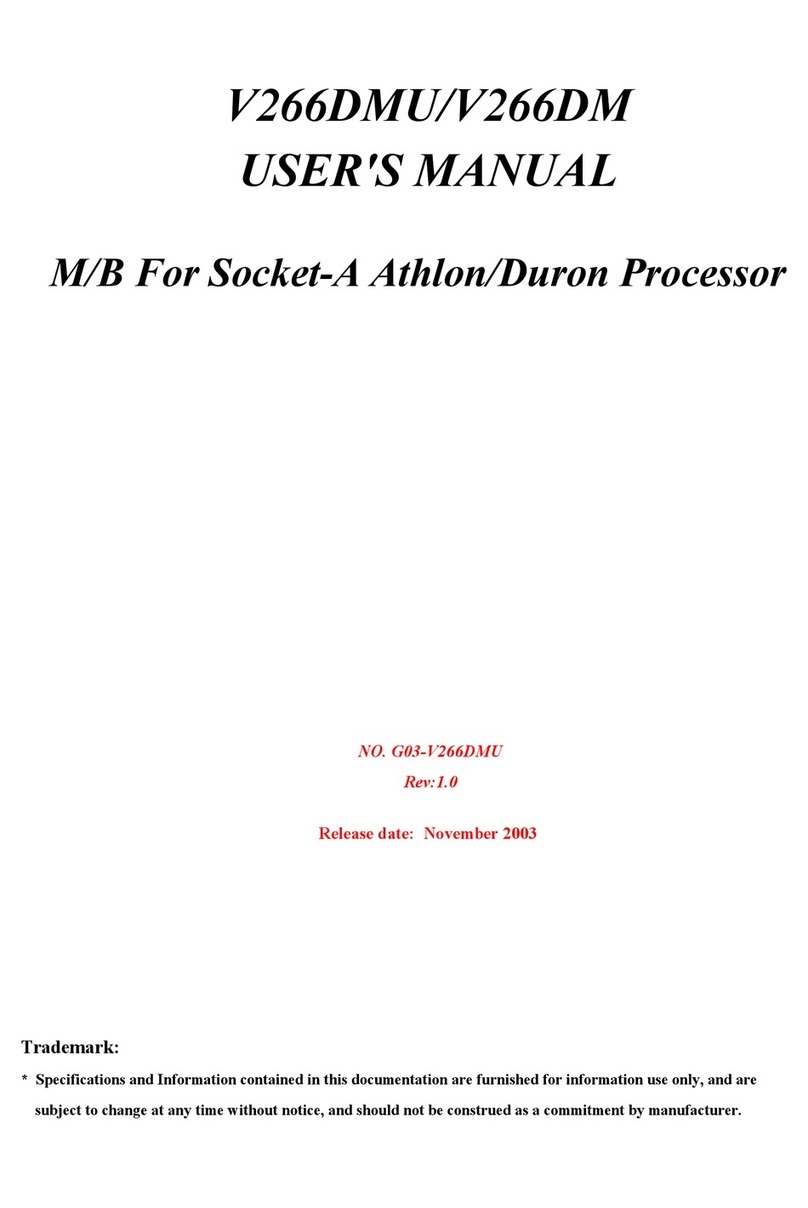
JETWAY
JETWAY V266DMU User manual
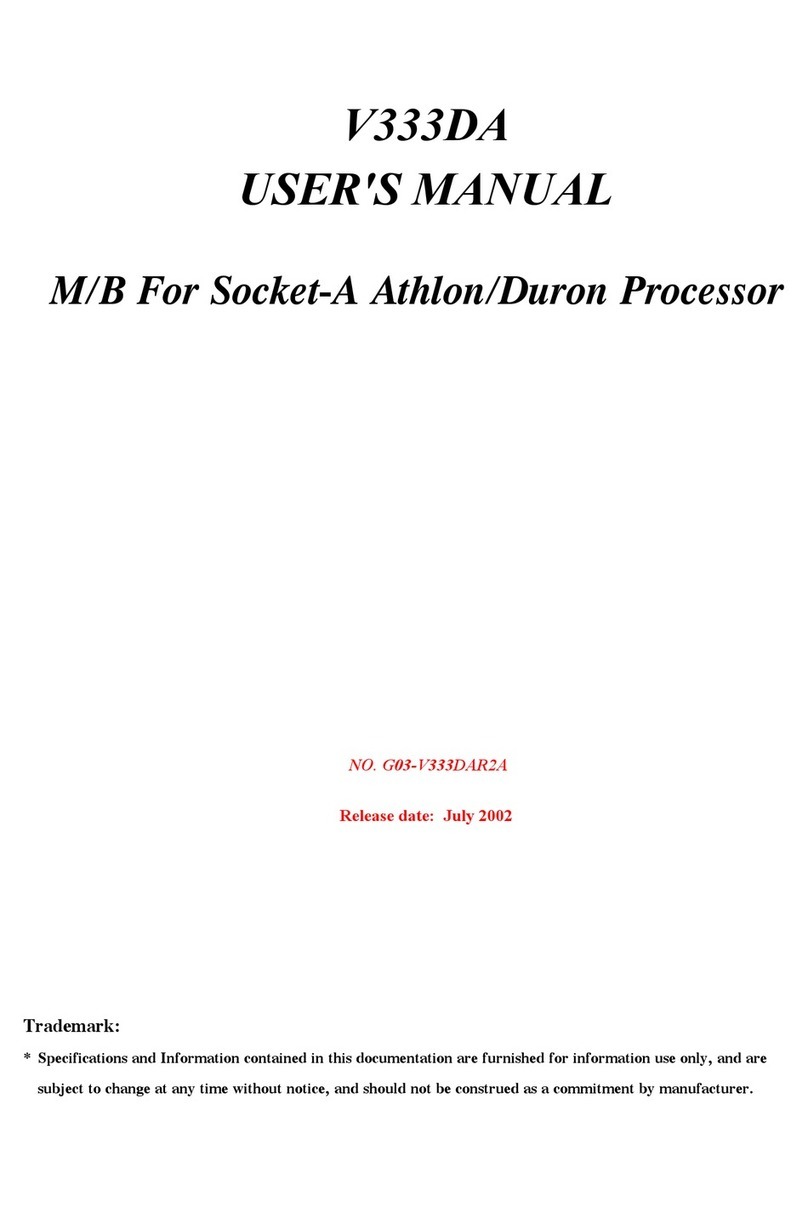
JETWAY
JETWAY V333DAR2A User manual

JETWAY
JETWAY NU591S User manual
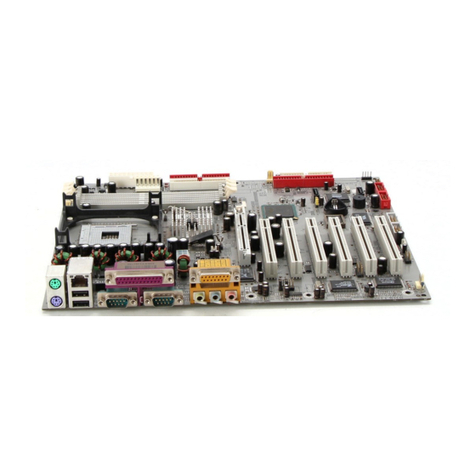
JETWAY
JETWAY ALIOTH User manual

JETWAY
JETWAY 845GEFC User manual
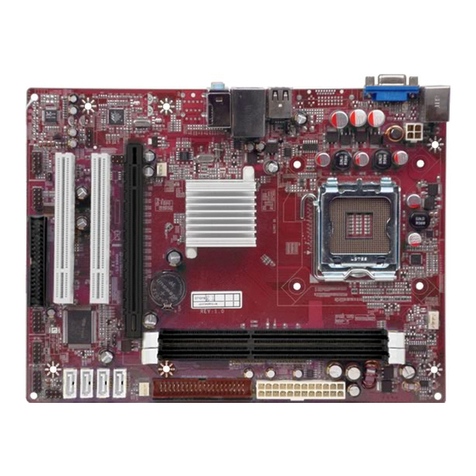
JETWAY
JETWAY IN73M3 User manual
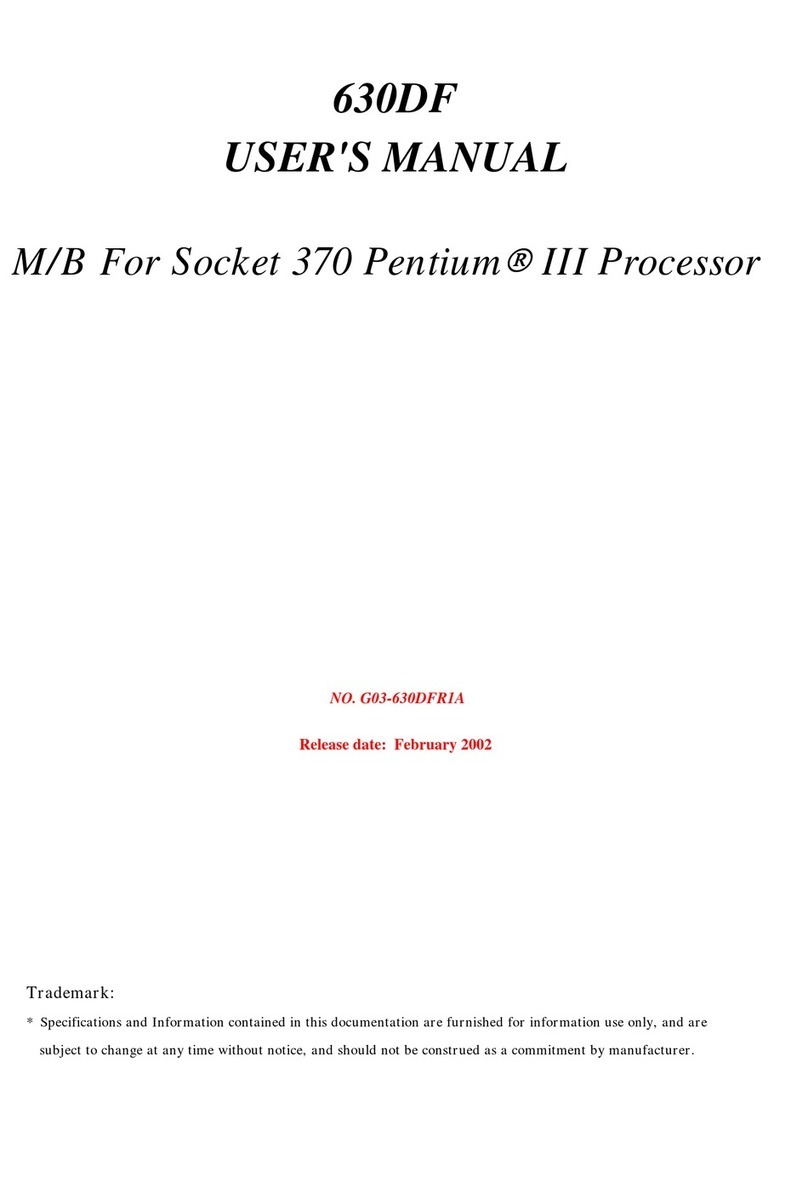
JETWAY
JETWAY 630DFR1A User manual
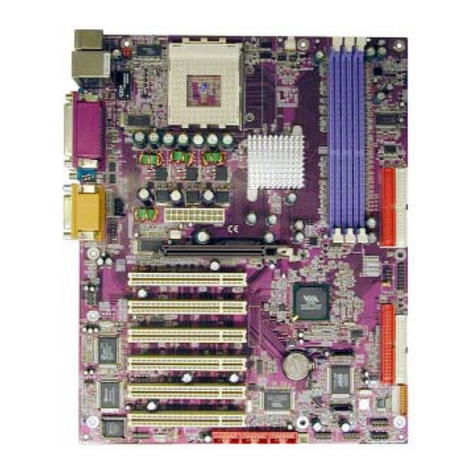
JETWAY
JETWAY POLARIS400 User manual
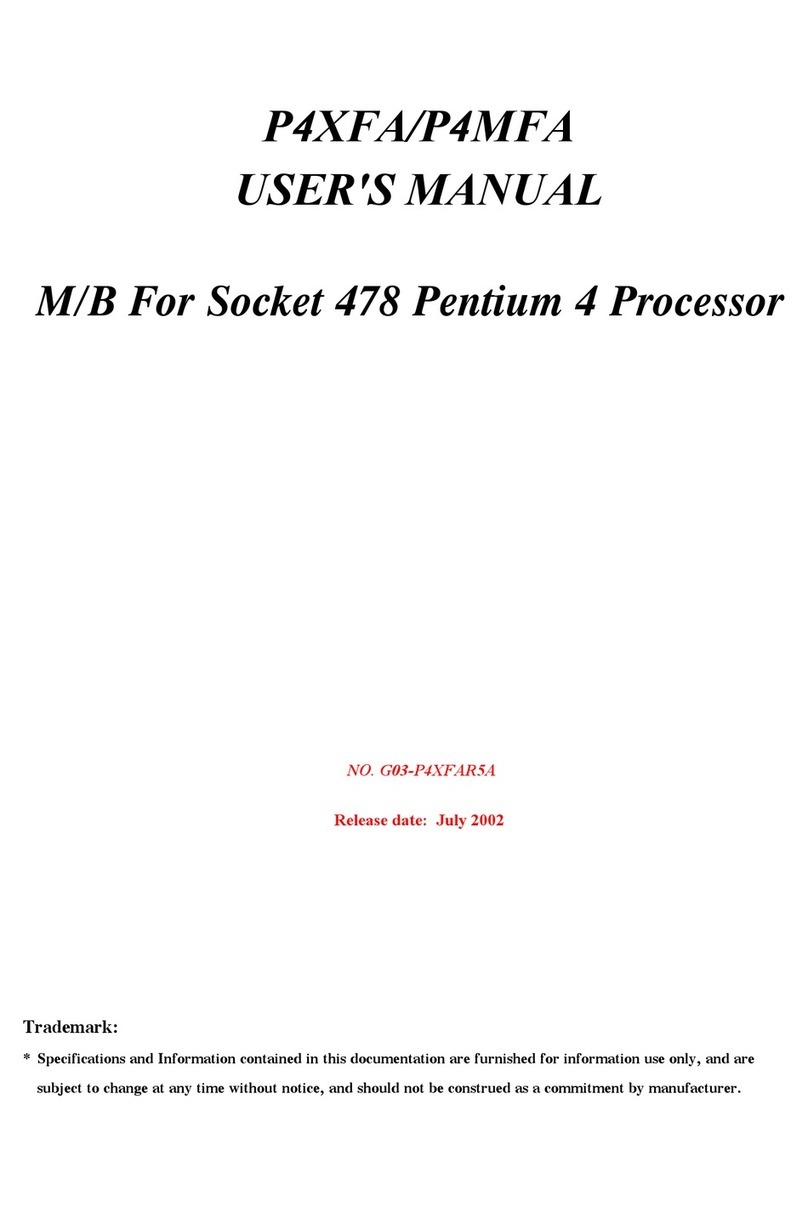
JETWAY
JETWAY P4XFAR5A User manual
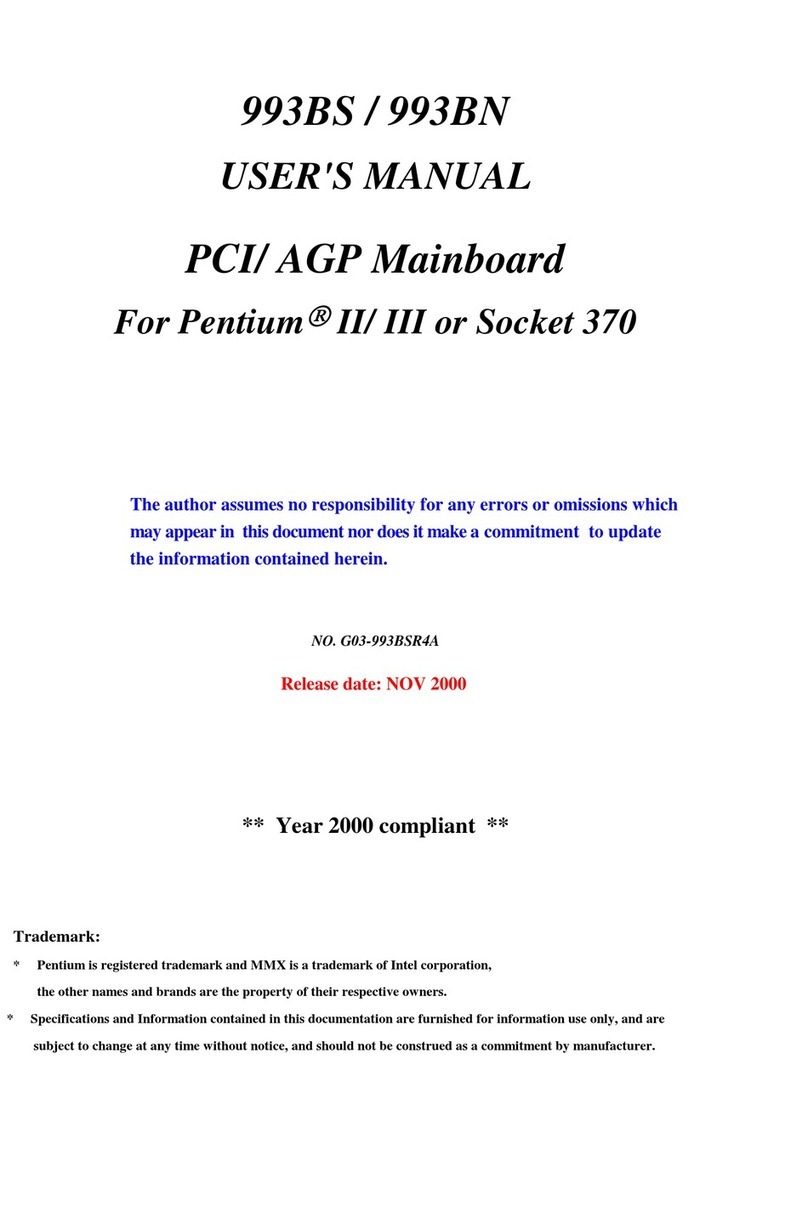
JETWAY
JETWAY 993BSR4A User manual
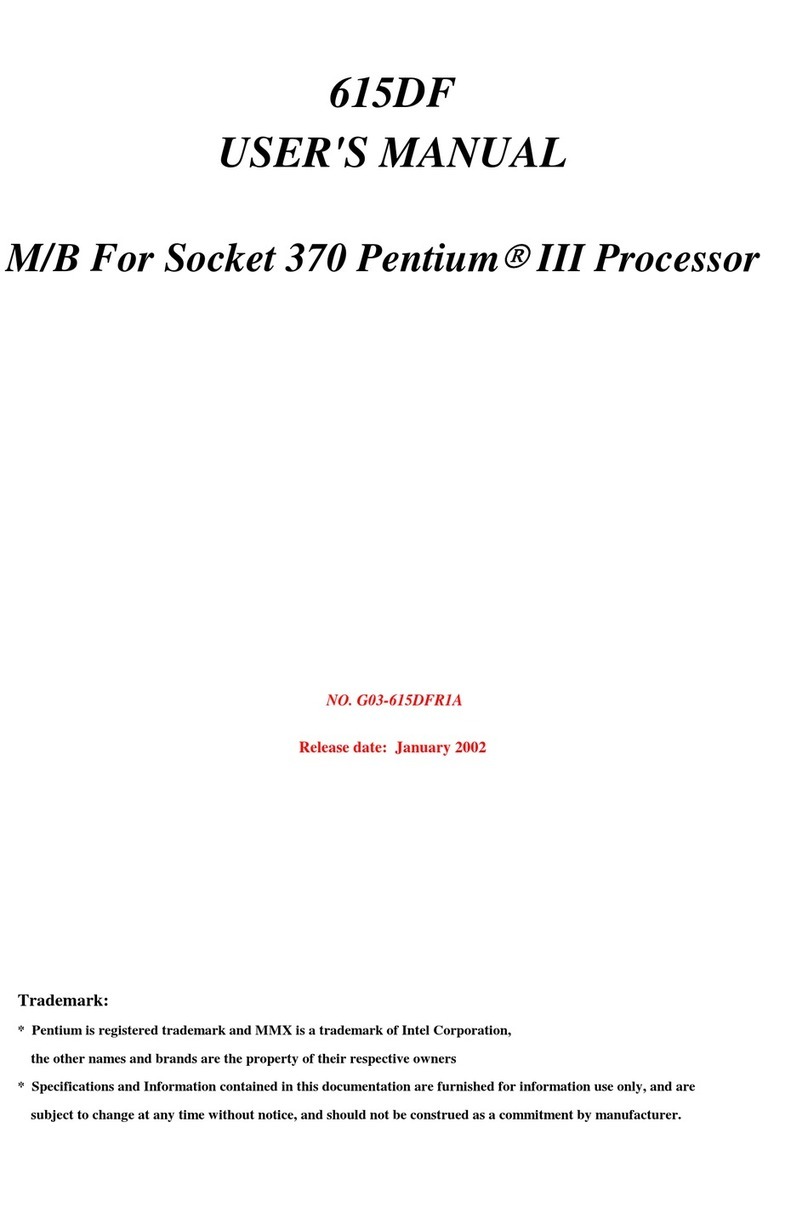
JETWAY
JETWAY 615DFR1A User manual
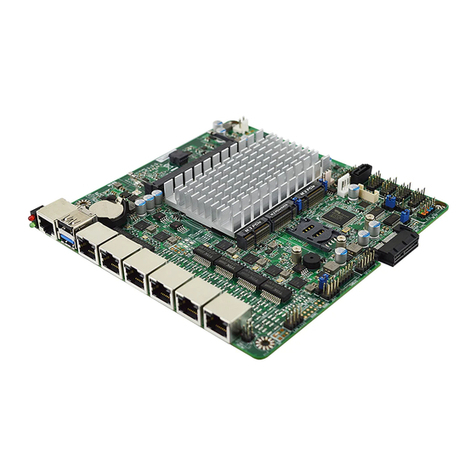
JETWAY
JETWAY MI05 Series User manual

JETWAY
JETWAY S450R2A User manual
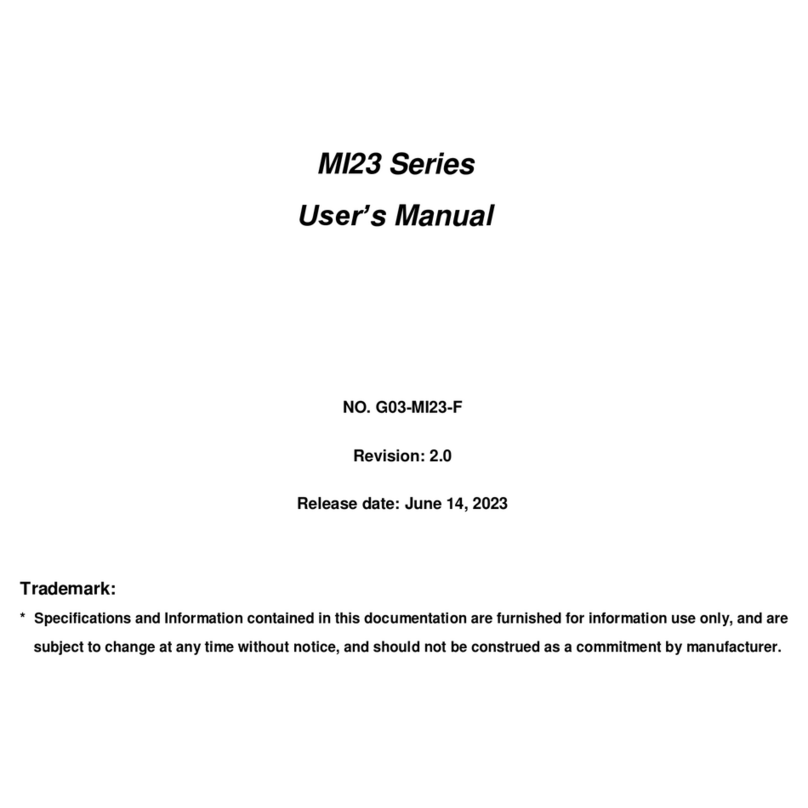
JETWAY
JETWAY MI23 Series User manual

JETWAY
JETWAY 845GLM User manual
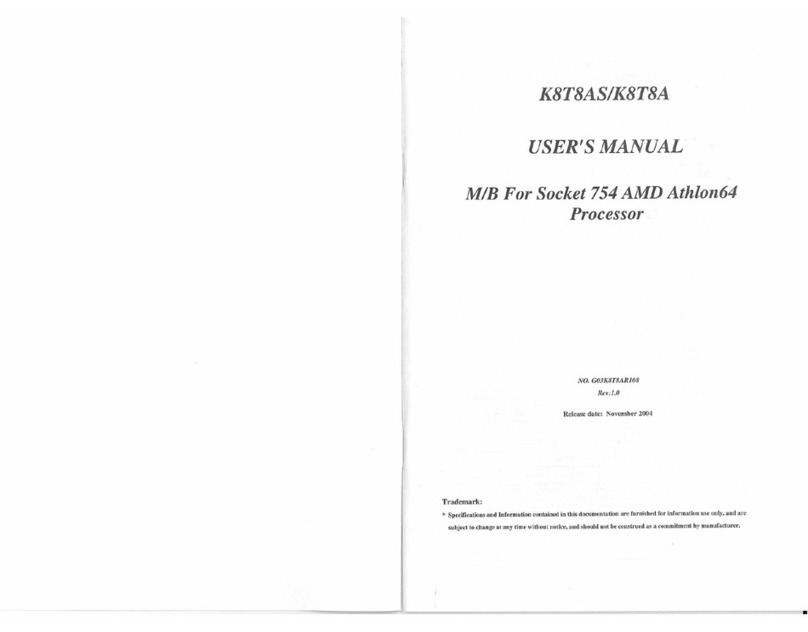
JETWAY
JETWAY K8T8AS - REV 3.0 User manual

JETWAY
JETWAY NU792V User manual
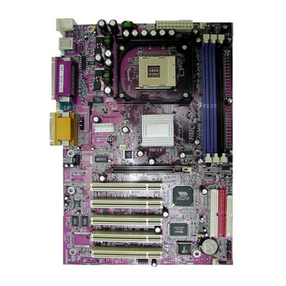
JETWAY
JETWAY P4XFCU User manual

JETWAY
JETWAY 695AS User manual
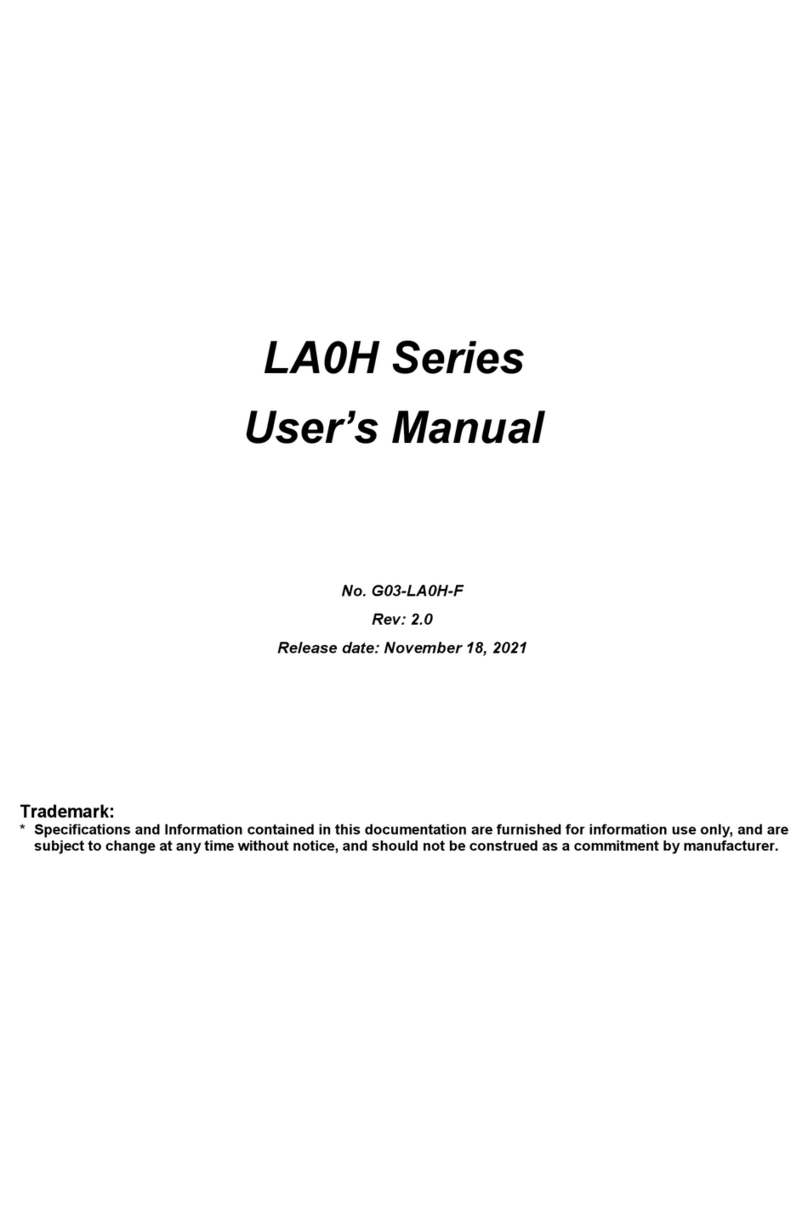
JETWAY
JETWAY LA0H Series User manual
